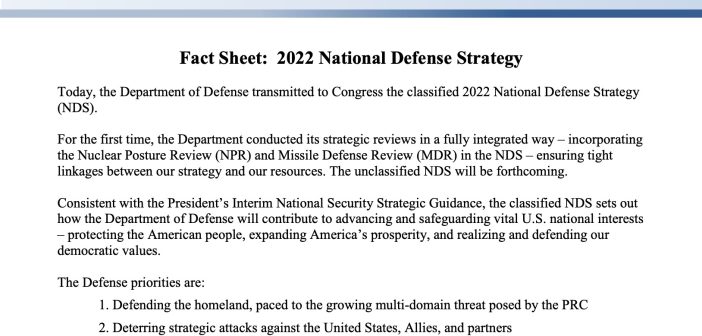By Dr. Harlan Ullman
Now that the Biden administration has released its National Security Strategy, the National Defense Strategy (NDS) will soon follow. But just as the NSS is a continuation of the past two administrations’. So too will be the case with the NDS.
And like past US strategic documents, including the NSS, the new NDS will have three fatal flaws. First, the two past NDS’s have not fully achieved their aims. Second, each was unaffordable. And, last, recruiting and retaining sufficient personnel to meet the needs of the NDS may no longer be possible.
How can this be? Arguably, the United States has the finest military and weaponry in the world — the latter being proven every day in the Ukraine War. The answers to this question should trigger an immediate and major review of US national security and defense strategy. Sadly, however, in this highly charged and pernicious partisan political environment, a serious and objective review may not be feasible.
The three key aims of the last two strategies were “to contain, deter and if war comes, defeat” four adversaries headed by China as “the pacing threat,” followed by Russia and then North Korea and Iran. However, none of these four potential enemies has been contained or deterred from taking actions inimical to the interests of the US and its allies and friends.
Consider China and Russia. China has greatly expanded its military. It has threatened Taiwan and its neighbors through “Wolf Warrior” diplomacy and its increasing access to markets and resources. Relations with the US, of which the US bears some responsibility, are at a post-Cold War low point. China continues to steal US and other states’ intellectual property. Hence, has China been contained or deterred?
Russia invaded Ukraine without cause. It has implied using nuclear weapons under certain extreme circumstances. It is using the energy weapon to blackmail and punish Western Europe over sanctions and has threatened cutting off shipments of grain and other foodstuffs that could precipitate a starvation catastrophe in Africa and Asia. Hence, has Russia been contained or deterred?
About defeating a thermonuclear armed enemy in war, China, Russia and America agree that a nuclear war should never be fought and cannot be won. Yet, Washington and its allies are increasingly fearful of a Chinese attack on Taiwan and the conflict in Ukrainian spilling over its borders, either scenario leading to a war. Further, the current NDS is not affordable.
Next year’s budget for all aspects of defense will be about $850 billion. With inflation, that for defense is close to 10 percent a year, and uncontrolled internal real annual cost growth of 5-7 percent for every item from precision guided weapons to people to pencils, annual defense increases of about 15-17 percent are needed just to stay even. That translates to an increase of $130-150 billion just for the Fiscal 2024 defense budget.
Much more will be needed for future years. But will Congress approve a trillion dollar defense budget short of war?
The underlying reason for uncontrolled cost growth is to pay for the extraordinary advances in technology that come at a price and deliver far greater military capability and for an all-volunteer force. The costs of incentives in salaries, bonuses and medical care are likewise increasing in double digits.
For example, an F-35 costs about $100 million each. The Ford-class nuclear aircraft carrier each costs about $15 billion and the new Columbia-class of ballistic submarines is approaching that figure. That does not include the costs of the carrier air wing and supporting surface forces or new ballistic nuclear missiles.
The military is experiencing shortfalls in manning. Recruiting numbers have not met targets. Retention is not the solution. That will lead to an older and more senior force. Who then will fill the more junior positions?
If these realities are ignored, the US military is headed for a 21st century version of the infamous post-Vietnam “hollow force” that crippled our military or possibly experience the same ignominious fate as the Russian army has in its bungled invasion of Ukraine.
A new NDS is needed now. The nation cannot afford to wait. This column and the book noted below have proposed a strategy that takes into account not only the military dangers but those of Massive Attacks of Disruption and Destruction caused by man and nature. Far more people have died of pandemics, starvation and other natural disasters than in the wars of this century.
The crucial question is whether the White House and Congress will recognize these perils and flaws in the NDS and take action. If not, the US and its military are at grave risk.
_______________________________
Dr. Harlan Ullman is senior advisor at Atlantic Council and the prime author of “shock and awe.” His latest book is The Fifth Horseman And The New MAD — How Massive Attacks Of Disruption Became The Looming Existential Danger To A Divided Nation And The World At Large is available on Amazon. He can be reached on Twitter @harlankullman.




